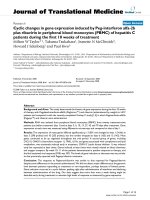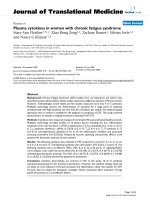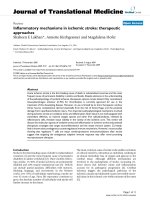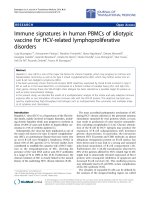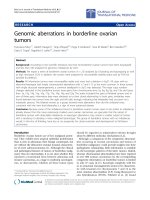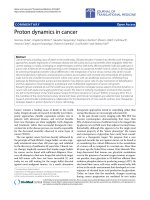Báo cáo hóa học: " Supplement use in sport: is there a potentially dangerous incongruence between rationale and practice?" docx
Bạn đang xem bản rút gọn của tài liệu. Xem và tải ngay bản đầy đủ của tài liệu tại đây (267.45 KB, 6 trang )
BioMed Central
Page 1 of 6
(page number not for citation purposes)
Journal of Occupational Medicine
and Toxicology
Open Access
Hypothesis
Supplement use in sport: is there a potentially dangerous
incongruence between rationale and practice?
Andrea Petróczi* and Declan P Naughton
Address: School of Life Sciences, Kingston University, Penrhyn Road, Kingston upon Thames, Surrey KT1 2EE, UK
Email: Andrea Petróczi* - ; Declan P Naughton -
* Corresponding author
Abstract
Background: Supplement use by athletes is complex and research supports the alarming notion
of misinformed decisions regarding supplements.
Hypothesis: A frequent divergence between the type of supplements chosen by athletes and the
rationale dictating the supplement use is hypothesized. Thus, a potentially dangerous incongruence
may exist between rationale and practice.
Testing the hypothesis: In the continued absence of reliable data on supplement use, an
alternative approach of studying the reasons underlying supplement use in athletes is proposed to
determine whether there is an incongruence between rationale and practice. Existing data from
large scale national surveys can be used to investigate this incongruence.
Implications of the hypothesis: In this report, analyses of distinctive patterns between the use
and rationale for use of supplements among athletes are recommended to explore this potentially
dangerous phenomenon.
Background
'Supplement' is an overarching name for vitamins, miner-
als, herbal remedies, traditional Asian remedies, amino
acids and other substances to be taken orally. They may
also be referred to as dietary, food or nutritional supple-
ments or ergogenic aids (supplements purported to
improve athletic performance) and are typically sold in
the form of tablets, capsules, soft gels, liquids, powders,
and bars. In the UK, most supplements are regulated as
foods and subject to the general provisions of the Food
Safety Act 1990, the Food Labelling Regulations 1996 and
the Trade Descriptions Act 1968. Supplements are not
required to exhibit efficacy before marketing, nor are they
subject to prior approval unless they are genetically mod-
ified or claimed to be new. Medicinal claims on packaging
or in an advertisement for a supplement, however, are
prohibited.
Widespread debate has accompanied the introduction of
new legislation on the use of dietary supplements within
the EU. Comprehension of detailed studies, ranging from
quantities and patterns of use to side-effects of supple-
ment consumption, has been impeded by variations in
terminology and practice amongst countries and user
groups. Some thirty thousand supplements are commer-
cially-available in the USA [1] with approximately half of
the adult female population being regular users [2-4],
with possible adverse effects of unregulated supplement
use on health and disease outcomes being of particular
interest [1].
Published: 29 May 2007
Journal of Occupational Medicine and Toxicology 2007, 2:4 doi:10.1186/1745-6673-2-4
Received: 30 January 2007
Accepted: 29 May 2007
This article is available from: />© 2007 Petróczi and Naughton; licensee BioMed Central Ltd.
This is an Open Access article distributed under the terms of the Creative Commons Attribution License ( />),
which permits unrestricted use, distribution, and reproduction in any medium, provided the original work is properly cited.
Journal of Occupational Medicine and Toxicology 2007, 2:4 />Page 2 of 6
(page number not for citation purposes)
Supplement use in sport
For some 50 years, competitive sports have operated
under strict regulation, and adherence to the ever-growing
list of prohibited substances [5] is expected from all high
performing athletes at all times. Gaining competitive
advantage, however, is more important than ever. Per-
sonal satisfaction as well as the athletes' livelihoods and
their organisations' prosperity depend on success. Ath-
letes naturally turn to supplements hoping to find herbs,
vitamins or minerals that provide the desired competitive
edge.
Worldwide supplement use among athletes, on average,
ranges between 40 and 60 percent [6-12]. Nutritional sup-
plements are typically used for their actual or anecdotal
physiological effects in increasing performance and
endurance, health maintenance or preventing injuries
[13-16], and the extent and amount of ergogenic 'drugs'
and supplements used by athletes shows a growing trend
[17]. Research linking supplement use to involvement in
physical activity and previous studies on decision making
patterns among these groups has focused on user sub-
group classifications [18-23]. While this enables an under-
standing of the gross difference in the patterns of use
between groups of users, it fails to give an explanation for
why those differences might occur. One key understudied
aspect is a potential mismatch between the decision mak-
ing and execution in practice.
Numerous factors can be involved in athletes' decisions to
use supplements including desired end points such as
increasing strength, endurance, training duration and
overcoming injury as well as avoiding sickness and com-
pensating for poor diet. Unfortunately, lack of knowledge
and/or misconceptions regarding supplements within
athlete populations have been documented for more than
a decade [21,24-27]. Recent research also shows that ath-
letes are willing to take supplements based on personal
recommendation without gathering reliable information
about the substances, often obtaining them directly from
retailers and internet sites [28,29]. Adolescents are more
willing to take supplements obediently if they are
informed by their parents/guardians, as opposed to by
coaches or resulting from published research [30].
Conflicting reports on knowledge levels within health
care professions demonstrate a wide variation in practice.
In one study, physicians and medical students were tested
to determine the level of their knowledge regarding effi-
cacy and toxicity, and drug interactions with herbal reme-
dies, and it was found that the mean test scores were only
slightly higher than scores obtained from random guess-
ing [31]. On the contrary, recent research among physi-
cians, nurses, nutritionists and pharmacists showed
adequate knowledge (average 66% on the knowledge
test), less confidence (55%) but noted a serious lack of
communication skills (average 2.2 out of 10) regarding
herbs and nutritional supplements [32]. Athletic trainers
and coaches were found to be reasonably knowledgeable,
especially those working with female athletes and/or hav-
ing more than 15 years of experience [33].
Supplement types and undesirable
consequences
A central issue in researching supplement use is the pau-
city of regulatory control of supplement providers cou-
pled to a poor understanding within the user community.
However, in broad terms many supplements have been
associated, rightly or wrongly, with performance enhance-
ment and/or health maintenance [10,15,34-37] includ-
ing: caffeine, ephedrine, creatine, whey protein,
antioxidants, ginseng, multivitamins, vitamin C, iron,
Echinacea and magnesium supplements. To illustrate the
complexities of studying this field, some thirty thousand
individual commercially-available supplements exist [1]
and over 60 supplements were listed in a recent UK survey
[38], summarised in Table 1.
Beyond contaminated products that easily lead to adverse
results in doping tests [8,39-45], vitamin products with
accurately listed compounds and substances can also be
harmful. High levels of vitamin and mineral intake can
lead to toxic side effects [10,35]. For example, the use of
iron supplementation by elite athletes is not uncommon
and whilst iron is beneficial for athletes with iron defi-
ciency, it can also cause harm with long-term use [46] or
certain medical conditions [47]. Similarly, excess intake of
vitamin C [48] can be harmful as well as in combination
with iron, which may cause damage to the gastrointestinal
tract (GI) and initiate or aggravate symptoms associated
with chronic GI disorders [49]. The long-term effects of
creatine are still unknown but short term side-effects such
as cramping and dehydration have been reported along
with the suggestion for its use to be under medical super-
vision [50]. Caffeine is no longer on the list of the IOC's
prohibited substances [53]. However, as athletes can use
it in training and competition, the relationship between
caffeine intake and resulting side-effects such as high
blood pressure warrant further study [52,53]. Whilst the
controversial natural stimulant, ephedrine, has a thresh-
old (concentration in the urine exceeds 10 μg/ml) for con-
sideration for doping [51], the serious harm, which may
be caused by ephedrine is well documented [53-55] and
the direct evidence eventually led to a ban on ephedrine
in 2004 by Food and Drug Administration (FDA), USA.
While the use of blood doping and erythropoietin (EPO)
are prohibited, cobalt is not included in the World Anti
Doping Association's list of prohibited substances [5].
Cobalt produces similar effects to hypoxia and results in
Journal of Occupational Medicine and Toxicology 2007, 2:4 />Page 3 of 6
(page number not for citation purposes)
enhanced erythropoiesis, thus in improved sport perform-
ance but such practice may be harmful [56].
The aim of this report is to highlight the difficulties
involved in generating accurate data on supplement use
and abuse in the absence of rigorous regulatory control. A
new approach is proposed to break through the conun-
drum presented by this 'catch 22' situation. Thus, estab-
lishing motive-use relationships for supplements, should
inform more beneficial use including the elimination of
adverse side-effects.
A frequent divergence between the type of supplements
chosen by athletes and the rationale dictating the supple-
ment use is hypothesized. Thus, a potentially dangerous
incongruence may exist between rationale and practice.
Testing the hypothesis
Congruence between rationale and supplements used by
athletes can be investigated by analyzing quantitative or
qualitative data. Although qualitative approaches have
the advantage of producing deep understanding of ath-
letes' motivations, data from these studies are not suitable
for hypothesis testing. Results from quantitative analyses,
assuming adequate sampling and appropriate statistical
analyses are objective and comparable. Data from this
type of research are normally collected via surveys or
structured interviews. Due to the ever present probability
of response bias, the use of an anonymous questionnaire
is preferable over face to face interviews [57]. The fact that
socially desirable responding increases as the sensitivity of
the issue being investigated increases [58] should also be
taken into consideration.
A sample is recommended to be drawn from a wide cross-
section of the athlete population with adequate data in
each subgroup of interest. The minimum required sample
size depends on the effect size and power of the test [59]
but usually is in the magnitude of hundreds in total with
a minimum of 20–25 per subgroup in case of continuous
variables [60] and a minimum of 5 observed cell frequen-
cies in cross classified categorical variables [61].
Empirical data collection regarding supplement use
among athletes can be prospective or retrospective. Retro-
spective studies collect information about the past and
relies on the recollection of events whilst other studies
investigate the present or follow participants over the
period of time in longitudinal studies. A longitudinal
research design is useful when a change over time is
important. This would be especially relevant in research
aimed to investigate decision making patterns and influ-
ences regarding the use of ergogenic aids. Alternatively,
one may attempt to derive the same results from a cross-
sectional design. However, results are only valuable if data
obtained from different age groups adequately represent
natural progression over time, thus employing the appro-
priate sampling method is critical.
Prospective studies have the advantage of using tailored
research design and methods with the specific research
question in mind. The level of measurement needed for
specific analytical procedures and the statistical power-
effect size-sample size triangle (if known) can also be
given a priori consideration. Published studies may be
used as pilot studies for estimating effect size and power,
hence determining the minimum sample size required for
noteworthy research.
In parallel to the increase in computational power, an
increasing number of studies utilise existing data that
might or might not be collected for the specific research
purpose. The least uncomplicated method is re-analyzing
existing data to test a new set of hypotheses. At the other
end of the spectrum, data mining allows researchers to
derive important and previously undiscovered but poten-
tially useful information from large volumes of data using
automated searching for meaningful and significant pat-
terns. Prime examples for these types of studies are
research projects relying on integrated clinical databases,
Table 1: Supplements taken by high performance UK athletes (in alphabetical order)
Listed by product/brand names Listed by components/contents
Ache Free, Cyclone, Build Up, Green Magic, Herbalife, Hydroxycut,
Immune Support, Kalms, Lactibiane, Leppin, Lucozade, Met-Rx, Minadex,
Mega EPA, MSN, Multibionta, Musashi Protein, Qlo, Slim Fast,
SportsFlex, Vitabalance
Aloe Vera, Alpha-lipoic Acid, Amino Acids, Arnica, Black strap molasses,
Calcium, Calendula, Carbohydrate & recovery drinks, C-Glutamine,
Chinese Tea, Chromium, Chondroitin, CLA (conjugated linoleic acid),
Cod liver oil, Coenzyme Q10, Colostrum, Cranberry juice tablets,
Digestive enzymes, Dried skimmed milk powder, Echinacea tea bags,
Electrolytes, Evening primrose oil, Ferrous gluconate, Fish oils, Flax seed
oil, Folic acid, Garlic capsules, Glucosomine, Harpagophytum
procumbens, Hydroxybetamethylbutyrate, L-Carnitine, L-Glutamine,
Maitake mushroom, Matltodextrin/Aspartame, meal replacement, Multi
Mineral Supplements, Olbas Oil, Protein drinks, Selenium, Soya protein,
Starflower oil, Sumpast, Tribulous Terrestris, Vitamin B, B combined
with Forceval capsules, Vitamin B complex, Vitamin D and E, Zinc
Journal of Occupational Medicine and Toxicology 2007, 2:4 />Page 4 of 6
(page number not for citation purposes)
large and cyclical national or international surveys or cen-
trally held statistical information on populations. Con-
trary to data mining that requires raw data, meta analysis
combines the results of published studies that address the
same research question. Although meta analysis is widely
used in epidemiological and evidence-based medical
studies in order to increase statistical power, this approach
is problematic in nutritional supplement research due to
the lack of sufficient regulations of the supplement mar-
ket. These problems are well illustrated in recent meta
analyses of antioxidant supplement use for cancer preven-
tion and their effects on mortality [62]. Declared interest
and publication bias (i.e., non-significant results are sel-
dom published) should also be taken into account when
one attempts meta analyses of supplement use, effects and
side effects in athletes.
Considering the costs of research and data collection,
especially when a large data set is required, multiple uses
of data facilitates a better use of public funds, hence it
should be encouraged. However, whether it is a hypothe-
sis driven statistical analysis or structured/unstructured
data mining, results from subsequent analyses should
contribute to the understanding of the phenomenon. In
this case, results must add to the body of knowledge
regarding supplement use and rationale in elite athletes.
Proposed approach
Existing data sets that include both 'supplements' and
'rationale/knowledge' variables can be used to obtain evi-
dence regarding athletes' potentially dangerous, incongru-
ent behaviour. Rationale or knowledge can also be
replaced by behavioural intention (if reasons for use are
specified) or beliefs about particular substances. Practi-
cally, any data that allow a scientifically and statistically
meaningful contingency table to be formed are suitable
for such analyses. It is suggested that existing, recent,
large-scale national surveys conducted among adult and
adolescent athletes by national level sport organisations
and governing bodies should be scrutinised to test the
hypothesis regarding supplement use in sports.
By creating a series of two by two contingency tables from
cross-tabling each supplement intake categories and rea-
sons for supplement use, we can:
i) test for relationships between answers (i.e., testing for
independence of the two variables);
ii) estimate the strength of this relationship from the pro-
portion of congruent pairs of answers (reasons given for
supplement use matches with the reported supplement
use);
iii) calculate the relative proportion of answers indicating
informed choices and incongruent answers (reasons given
for supplement use are not followed by the appropriate
supplement) and compare the observed pattern of supple-
ment use to an expected pattern; and
iv) test whether this pattern characterises the athlete pop-
ulation.
A pair of answers is congruent if there is an agreement
between an athlete's self-reported supplement use and
rationale. The connection is not explicitly made by the
athlete but calculated afterwards from answers given on
two separate and seemingly independent questions. In
surveys of supplement use, athletes are often asked about
the substances they have had experience with and some of
these surveys also contain explicit questions regarding the
reasons behind supplement taking [9,12,21,38,63]. Table
2 illustrates a simplified scenario of one particular reason
for supplementing and the corresponding substance. For
instance, a group of athletes were asked: i) whether they
use supplements to increase their strength and power out-
put; and ii) if they take creatine – a substance known for
this effect [10] and currently not sanctioned in competi-
tive sport. Answer options to both questions were limited
to dichotomous (Yes/No) responses, thus its contingency
table is a two-by-two square. Assume that exactly 100 ath-
letes were asked and 75 (%) of them take supplements to
maintain or increase strength. In an ideal case when all
athletes make an informed and rational decision about
supplements, we would expect X to be 75 and W to be 25,
whereas both Y and Z should be zero. This {75, 0, 25, 0}
is the expected pattern under the assumption of the fully
informed choice. On the contrary, a pattern of X = 0, Z =
75, Y = 25 and W = 0 would indicate a great deal of con-
fusion or complete misinformation about supplements
and their physiological effects.
However, in real life it is not likely that we can observe a
perfect pattern, thus we use appropriate statistical analyses
[60] to determine whether the observed pattern signifi-
cantly differs from: i) what is expected; or ii) what would
happen by random chance if we assume that the two ques-
tions are unrelated. Descriptive statistics obtained from
the sample are very interesting and informative but no
inferences can be made to the population from which the
sample was drawn.
For example, we assume that protein use is common
among professional male players from sports where
strength is important. In the UK Sport survey [38] 186
male professional players indicated supplement use, of
which 106 (57%) listed and 87 (47%) used whey protein.
Simple descriptive statistics (frequency and percentage by
variables) do not tell us whether the group of 106 players
Journal of Occupational Medicine and Toxicology 2007, 2:4 />Page 5 of 6
(page number not for citation purposes)
wishing to increase strength contained all 87 who
reported the use of whey protein. Therefore, using chi-
square tests of association and phi coefficients offer a bet-
ter approach to delineate athletes' informed choices by
considering the two variables (reason for use and supple-
ment used) simultaneously. In this example, the test
results shows significant (
χ
2
= 44.28, p < .001) and rela-
tively strong (phi = .49, p < .001) associations between
whey protein use and the reason 'maintaining strength' in
athletes' answers suggesting that athletes make informed
choice regarding strength and protein use. Re-creating the
contingency table given in Table 2, shows that X = 72
(68%), W = 65 (81%), Y = 15 (19%) and Z = 34 (32%),
where ΣXZ and ΣWY are 100%. Comparing these cells to
the expected pattern under the assumption of the fully
informed choice {106,0,80,0}, we see that: i) 68 % those
who wish to maintain strength are taking whey protein
and the observed pattern differs significantly from the
expected pattern of the fully informed choice (
χ
2
= 10.9, p
= .001); and ii) 81% of those who are not interested in
maintaining strength are not taking protein either and it
confirms to the expected pattern (
χ
2
= 2.81, p = .094).
The result from the above example is not surprising as
protein is a fairly well-known and widely used supple-
ment but the analyses of other substances may not show
the same level of confidence. Statistical procedures pro-
posed here (i.e., tests of independence and strength of
association) provide evidence that the phenomenon
directly evidenced in the sample is observable in the pop-
ulation as well. Because surveys are normally not limited
to a sole reason and a single substance, such an approach
also allows comparison of strength of associations across
supplement categories and reasons.
Implications of the hypothesis
In order to regulate the European market, the European
Union (EU) issued the Food Supplements Directive 2002/
46/EC, which was implemented in the UK in 2003, effec-
tive from August 2005 [64]. The Food Standards Agency
has successfully rebutted the EU's attempt and, by virtue
of the derogation in Article 4.6. of the Directive, which
permits the continued use of vitamins and minerals not
on the 'positive lists', the UK supplement market will
remain semi-regulated at least until 2009 [65]. Unless
clear evidence is found for adverse effects, health warnings
are therefore not likely to be placed on nutritional supple-
ments [9]. Thus, widespread supplement use is likely to
remain at a high level or to increase further. The conun-
drum is obtaining the strong evidence in the absence of
regulation which severely limits the validity of clinical
investigations.
Competing interests
The author(s) declare that they have no competing inter-
ests.
Authors' contributions
AP studied published surveys (e.g., the UK Sport survey),
conceived the study and performed the statistical analyses
for the example. DN added considerations of supplement
use and helped to draft the manuscript. All authors read
and approved the manuscript.
References
1. Palmer ME, Haller C, McKinney PE, Klein-Scwartz W, Tschirgi A,
Smolinske SC, Woolf A, Sprague B, Ko R, Everson G: Adverse
events associated with dietary supplements: an observa-
tional study. Lancet 2003, 361:101-106.
2. Miller CK, Russell T, Kissling G: Decision-making patterns for
dietary supplement purchases among women aged 25 to 45
years. J Am Diet Assoc 2003, 103:1523-1526.
3. Neuhouser ML: Dietary supplement use by American women:
challenges in assessing patterns of use, motives and costs. J
Nutr 2003:1992-1996.
4. Radimer K, Bindewald B, Hughes J, Ervin B, Swanson C, Picciano MF:
Dietary supplement use by US adults: Data from the
National Health and Nutrition Examination Survey, 1999–
2000. Am J Epidem 2004, 160:339-349.
5. WADA 2006: The World Anti-Doping Code. The 2007 Pro-
hibited List. International standard. [a-
ama.org/rtecontent/document/2007_List_En.pdf].
6. Erdman KA, Fung TS, Reimer RA: Influence of performance level
on dietary supplementation in elite Canadian athletes. Med
Sci Sports Exerc 2006, 38:349-356.
7. Huang S, Johnson K, Pipe A: The use of dietary supplements and
medication by Canadian athletes in the Atlanta and Sydney
Olympic Games. Clin J Sport Med 2006, 16:27-33.
8. Maugham RJ: Contamination of dietary supplements and posi-
tive drug tests in sport. J Sport Sci 2005, 23:883-889.
9. Nieper A: Nutritional supplement practices in UK junior
national track and field athletes. Brit J Sport Med 2005,
39:645-649.
10. Silver MD: Use of ergogenic aids by athletes. J Am Acad Ortho-
paed Surg 2001, 9:61-70.
11. Slater G, Tan B, Teh KC: Dietary supplementation practices of
Singaporean athletes. Int J Exerc Metab 2003, 13:20-32.
Table 2: Contingency table of creatine use and strength*
Reason: increase strength and power output
Yes No
Supplement: creatine Yes XYΣXY
No ZWΣZW
ΣXZ ΣYW
* ΣXZ = all athletes who use supplements to increase strength, ΣYW = all athletes who does not indicate increased strength as reason for
supplement use, ΣXY = all athletes who take creatine and ΣZW = all athletes who do not take creatine.
Journal of Occupational Medicine and Toxicology 2007, 2:4 />Page 6 of 6
(page number not for citation purposes)
12. Sundgot-Borgen J, Berglund B, Torsveit MK: Nutritional supple-
ments in Norvegian elite athletes – impact of international
ranking and advisors. Scand J Med Sci Sport 2003, 13:138-144.
13. Aoi W, Naito Y, Yoshikawa T: Exercise and functional foods.
Nutr J 2006, 5:15. doi:10.1186/1475-2891-5-15.
14. Armsey TD, Green GA: Nutrition supplements: Science vs
hype. Physician Sportmed 1997, 25:77-92.
15. Kreider RB, Almada AL, Antonio J, Broeder C, Earnest C, Green-
wood M, Incledon T, Kalman DS, Kleiner SM, Leutholtz B, Lowery
LM, Mendel R, Stout JR, Willoughby DS, Ziegenfuss TN: ISSN exer-
cise & sport nutrition review: research & recommendation.
Sports Nutr Rev J 2004, 1:1-44.
16. Lawrence ME, Kirby DF: Nutrition and Sports Supplements:
Fact or Fiction. J Clin Gastroenterol 2002, 35:299-306.
17. Telkin KA, Kravitz L: The growing trend of ergogenic drugs and
supplements. ACSM Health Fitness J 2004, 8:15-18.
18. Dorsch KD, Bell AB: Dietary supplement use in adolescents.
Current Opin Pediatr 2005, 17:653-657.
19. Green GA, Uryasz FD, Petr TA, Bray C: NCAA study of substance
use and abuse habits of college student-athletes. Clin J Sport
Med 2001, 11:51-56.
20. Hespel P, Maughan RJ, Greenhaff PL: Dietary supplements for
football. J Sports Sci 2006, 24:749-761.
21. Massad SJ, Shier NW, Koceja DM, Ellis NT: High school athletes
and supplements: A study of knowledge and use. Int J Sport
Nutr 1995, 5:232-245.
22. Ronsen O, Sundgot-Borgen J, Maehlum S: Supplement use and
nutritional habits in Norvegian elite athletes. Scand J Med Sci
Sports 1999, 9:28-35.
23. Schulze MB, Hoffman K, Kroke A, Boeing H: Dietary patterns and
their association with food and nutrient intake in the Euro-
pean prospective investigation into cancer and nutrition
(EPIC) – Potsdam study.
Brit J Nutr 2001, 85:363-373.
24. Burns RD, Schiller MR, Fada RD, Merrick MA, Wolf KN: Intercol-
legiate student athlete use of nutritional supplements and
the role of athletic trainers and dietitians in nutrition coun-
seling. J Am Diet Assoc 2004, 104:246-249.
25. Economos R, Bortz S, Nelson M: Nutritional practices of elite
athletes. Sports Med 1993, 16:381-389.
26. Jonnalagadda SS, Rosenbloom CA, Skinner R: Dietary practices,
attitudes and physiological status of collegiate freshman
football players. J Strength Cond Res 2001, 15:507-513.
27. Worme JD, Doubt TJ, Singh A, Ryan CJ, Moses FM, Deuster PA: Die-
tary patterns, gastrointestinal complaints, and nutrition
knowledge of recreational triathletes. Am J Clin Nutr 1990,
51:690-697.
28. Laure P, Binsinger C: Adolescent athletes and the demand and
supply of drugs to improve their performance. J Sport Sci Med
2005, 4:272-277.
29. O'Dea J: Consumption of nutritional supplements among
adolescents: usage and perceived benefits. Health Educ Res
2003, 18:98-107.
30. Bartee RT, Grandjean B, Dunn MS, Perko MA, Eddy JM, Wang MQ:
Predictors of dietary supplement use among adolescent ath-
letes. Pediatric Exerc Sci 2004, 16:250-264.
31. Suchard JR, Suchard MA, Steinfeldt JL: Physician knowledge of
herbal toxicities and adverse herb-drug interactions. Eur J
Emerg Med 2004, 11:193-197.
32. Kemper KJ, Gardiner P, Gobble J, Woods C: Expertise about
herbs and dietary supplements among diverse health profes-
sionals. BMC Complement Altern Med 2006, 6:15. doi:10.1186/1472-
6882-6-15.
33. Smith-Rockwell M, Nickols-Richardson SM, Thye FW: Nutrition
knowledge, and practices of coaches and athletic trainers at
a division 1 university. Int J Sport Nurt Exerc Metab 2001,
11:174-185.
34. Calfee R, Fadale P:
Popular ergogenic drugs and supplements in
young athletes. Pediatrics 2006, 117:577-589.
35. Juhn MS: Popular sports supplements and ergogenic aids.
Sports Med 2003, 33:921-939.
36. Maugham RJ: Nutritional ergogenic aids and exercise perform-
ance. Nutr Res Rev 1999, 12:255-280.
37. Maugham RJ, King DS, Lea T: Dietary supplements. J Sport Sci
2004, 22:95-113.
38. UK Sport. Drug-free sport survey. London UK Sport 2005.
39. Baume N, Mahler M, Kamber P, Saugy M: Research of stimulants
and anabolic steroids in dietary supplements. Scand J Med Sci
Sports 2006, 16:41-48.
40. Baylis AM, Cameron-Smith D, Burke M: Inadvertent doping
through supplement use by athletes: assessment and man-
agement of the risks in Australia. Int J Sport Nutr Exerc Metab
2001, 11:365-383.
41. Green GA, Catlin DH, Starcevic B: Analysis of over-the-counter
dietary supplements. Clin J Sport Med 2001, 11:254-259.
42. Haller CA, Duan M, Benowitz NL, Jacob III P: Concentration of
ephedra alkaloids and caffeine in commercial dietary supple-
ments. J Analytic Toxicol 2004, 28:145-151.
43. Kamber M, Baume N, Saugy M, Rivier L: Nutritional supplements
as a source for positive doping cases? Int J Sport Nutr Exerc Metab
2001, 11:258-263.
44. Pipe A, Ayotte C: Nutritional supplements and doping. Clin J
Sport Med 2002, 12:245-249.
45. Striegel H, Vollcommer G, Hortsmann T, Niess AM: Contaminated
nutritional supplements – legal protection for elite athletes
who tested positive: A case report from Germany. J Sports Sci
2005, 23:723-726.
46. Powers KM, Smith-Weller T, Franklin GM, Longstreth WT Jr, Swan-
son PD, Checkoway H: Parkinson's disease risks associated
with dietary iron, manganese, and other nutrient intakes.
Neurology 2003,
60:1761-1766.
47. Zoller H, Vogel W: Iron supplementation in athletes – first do
no harm. Nutrition 2004, 20:615-619.
48. Wroblewski K: Can the administration of large doses of vita-
min C have a harmful effect? Pol Merkuriusz Lek 2005,
19:600-603.
49. Fisher AEO, Naughton DP: Iron supplements: the quick fix with
long-term consequences. Nutr J 2004, 3:1475-2891.
50. Benzi G, Ceci A: Creatine as nutritional supplementation and
medical product. J Sport Med Phys Fitness 2001, 41:1-10.
51. Tokish JM, Kocher MS, Hawkins RJ: Ergogenic Aids: A Review of
Basic Science, Performance, Side Effects, and Status in
Sports. Am J Sports Med 2004, 32:1543-1553.
52. James JE: Critical review of dietary caffeine and blood pres-
sure: a relationship that should be taken more seriously. Psy-
chosom Med 2004, 66:63-71.
53. Haller CA, Meier KH, Olson KR: Seizures reported in associa-
tion with use of dietary supplements. Clin Toxicol (Phila) 2005,
43:23-30.
54. Shao A, Hathcock JN: Risk assessment for creatine monohy-
drate. Regul Toxicol Pharmacol 2006, 45:242-251.
55. Shekelle PG, Hardy ML, Morton SC, Maglione M, Mojica WA, Suttorp
MJ, Rhodes SL, Jungvig L, Gagné J: Efficacy and Safety of Ephedra
and Ephedrine for Weight Loss and Athletic Performance. A
Meta-analysis. JAMA 2003, 289:1537-1545.
56. Lippi G, Franchini M, Guidi GC: Blood doping by cobalt. Should
we measure cobalt in athletes? J Occupational Med Toxicol 2006,
1:18. doi:10.1186/1745-6673-1-18.
57. Paulhus DL, Reid DB: Enhancement and denial in socially desir-
able responding. J Pers Soc Psychol 1991, 60:307-317.
58. Tardia CH, Dindia K: Self-disclosure: Strategic revelation of
information in personal and professional relationships. In The
handbook of communication skills 3rd edition. Edited by: Hargie O. Lon-
don Routledge; 2006:229-266.
59. Lenth RV: Some Practical Guidelines for Effective Sample
Size Determination. Am Statistician 2001, 55:187-193.
60. Tabachnick BG, Fidell LS: Using multivariate statistics. 4th edi-
tion. Boston, MA:Allyn & Bacon; 2001.
61. Wayne WD: Applied nonparametric statistics. 2nd edition.
Boston, MA: PWS-Kent; 1990.
62. Bjelakovic G, Nikolova D, Gluud LL, Simonetti RG, Gluud C: Mortal-
ity in randomised trials of antioxidant supplements for pri-
mary and secondary prevention. JAMA 2007, 297:842-857.
63. Ziegler PJ, Nelson JA, Jonnalagadda SS: Use of dietary supple-
ments by elite figure skaters. Int J Sport Nutr Exerc Metab 2003,
13:266-276.
64. Food Standards Agency [ />industry]
65. Food Standards Agency: Full regulatory impact assessment. The
food supplements (England) regulations 2003 [ />multimedia/pdfs/foodsuppsria.pdf].
